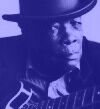Shades R&B; History
[ Next ]
The Primer is dedicated to promoting Rhythm and Blues, but it's clear to anyone with a passing interest in the music that it really doesn't stick to any clear definition of the genre.
As a Primer, it's an attempt to illustrate the music, the labels and the artists of a particular style but it cannot lay claim to be a theoretical, academic or scholarly treatise. Partly this is because I am not necessarily best equipped to do it full justice and partly because there are others who are far better qualified to deliver a definitive history of the form.
So what you'll find below is a partial, subjective and therefore potentially flawed account of the music that the Primer promotes, designed to provide a background and context for what you'll find on the rest of the site.
 |
| John Lee Hooker |
R&B clearly has its origins in the secular folk music of the American black musician - the Blues. For me, the Blues is essentially about emotional expression and is predominantly a vocal medium - although there are many examples of blues instrumentals to refute this assertion, it is the singer who expresses the feelings of the blues; and there are a number of vocal techniques which are used to create the desired effects. There are of course a range of blues instrumentations which accompany the central vocal performance (the bending of guitar strings, the classic bottleneck of so many of the great blues guitarists, the harmonica imitating the idioms of the human voice etc. etc.) and which clearly help to create the unique blues performance.
Although much has been written on the blues, the origins of the music are not particularly well documented. It is clearly influenced by the work songs of the deep South, ragtime, church music, minstrel shows and folk, even some forms of white popular music. The earliest and most frequently cited references to the form are to be found in the early 1900s and one of the early musical reference points is the W.C. Handy composition 'Memphis Blues'.
Rural blues developed mainly in the three key regions of Georgia, Texas and Mississippi. Excellent examples of the Georgia style include Blind Willie McTell and Blind Boy Fuller, highly melodic and less intense than the Mississippi stylists such as Charley Patton, Robert Johnson and Johnny Shines.
Interestingly however, perhaps the first real blues recordings were made in the 1920s by the women of the blues, artists such as Ma Rainey, Ida Cox and the wonderful Bessie Smith. At this stage the performances were still largely based on their stage backgrounds, backed by the leading jazz players of the day.
 |
| Muddy Waters |
Some of the major urban conurbations included Atlanta, Memphis and St. Louis but there are critical milestones to be found in any number of places. John Lee Hooker found a home in Detroit, the great T-Bone Walker established a following on the West Coast and Chicago exerted an influence of real significance - Sonny Boy Williamson, Muddy Waters, Little Walter, Howlin' Wolf, Elmore James and Otis Spann were all based there.
The Blues has influenced just about everything musically which subsequently developed. Not least of which was the emergence of what came to be known as Rhythm and Blues
[ Next ]